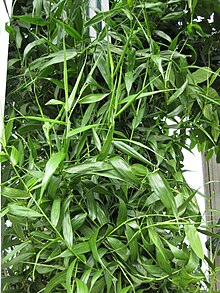Flagellaria indica
| Whip vine | |
|---|---|

| |
| Flagellaria indica | |
| Scientific classification | |
| Kingdom: | Plantae |
| Clade: | Tracheophytes |
| Clade: | Angiosperms |
| Clade: | Monocots |
| Clade: | Commelinids |
| Order: | Poales |
| Family: | Flagellariaceae |
| Genus: | Flagellaria |
| Species: | F. indica
|
| Binomial name | |
| Flagellaria indica | |
Flagellaria indica is a climbing plant found in many of the tropical and subtropical regions of the Old World, India, Bangladesh, Southeast Asia, Polynesia, and Australia.
A strong climber, it grows often up to 15 m tall, with thick cane-like stems exceeding 15 mm in diameter. Its leaves, without hairs, are 10 to 40 cm long, and 5 to 20 mm wide. A coiled apex of the leaf forms the holding part of the climbing plant. Fragrant white flowers form in panicles, 10 to 25 cm long. The fruit is an inedible, greenish-red drupe, 5 mm in diameter, usually with only one seed.
Because of its wide distribution, many local common names are used, such as whip vine, hell tail, supplejack, false rattan, and bush cane.


References
- "Flagellaria indica". PlantNET - NSW Flora Online. Retrieved 2010-02-28.
- *Florabase (western Australia)
